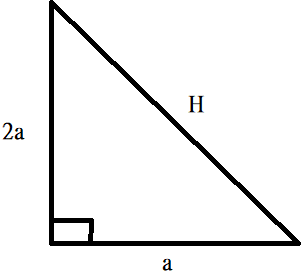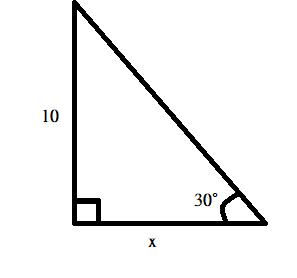In this blog on trigonometry, we will solve some trigonometry questions and answers to brush up on our concept using identities. Trigonometry is a combination of two Greek words- ‘Trigonon’ meaning a triangle and ‘metron’ meaning measure. In this blog, we will solve some of the problem statements to understand this concept better. Test your understanding of the practice problem and solve the step-by-step solution.
Solved Trigonometry questions
Problem 1: Find the length of the side unknown?

Solution :
x = \frac{20} {tan(45°)} = 20
H = \frac{20} {sin(45°)} = 28.28Problem 2:Find all sides of the right-angle triangle if the area of the is 625.

Solution:
Here, area of a triangle =\frac{1}{2}base *height
Area of triangle=\frac{1}{2} (2a)(a) = 625
So, a = 25 , 2a = 50
Using Pythagoras’s theorem
(opp.)^2 + (adj.)^2 = (Hypo.)^2 \\
(2a)^2 + (a)^2 = H^2
H = a √(5)= 25 √(5)Problem 3:Find the length if DB is perpendicular to AB.

Solution :
Given AC perpendicular to DB means that triangles ACD and ACB are right triangles.
Hence,
\ tan (30°) = \frac {10} {AC} or AC = \frac {10} {tan (30°)}
BC = 20 – AC = 19 - \frac {10} {tan (30°)}
Pythagoras’s theorem applied to right \triangle ACB:
11^2 + BC^2 = x^2
solve for x and substitute BC: x = \sqrt ([ 10^2 + (20 - \frac {10} {tan (30°)})^2 )
= 107.12 (rounded to 3 significant digits)Problem 4: Find the value of \tan \theta 
Solution :
We have the opposite side (O) =10 and Adjacent side = x
\tan \theta =\frac{opposite}{adjacent}
\tan 30= \frac{10}{x}
x=\frac{10}{\ tan 30}
x= 17.33Problem 5: Solve 2 \tan(\theta)- \cot(\theta)=-1
Solution :
2\tan\theta-\cot \theta=-1 \\
2\tan^2\theta+tan\ \theta-1=0
\left(tan\theta+1\right)\left(2tan\theta-1\right)=0
Now,tan\theta+1=0 or 2tan\theta-1=0
tan\theta=-1=tan\left(\frac{-\pi}{4}\right)or tan\theta=\frac{1}{2\ }=tan\alpha\left(say\right)\\
\theta=n\pi+(\frac{-\pi}{4})\ or\ \theta=n\pi+\alpha, Where \alpha=\tan^{-1}(\frac{1}{2}) and\ n\in ZProblem 6: Solve \tan 2 \theta \tan \theta = 1
Solution:
tan\left(2\theta\right)tan\ \theta=1
\left(\frac{sin\ 2\theta}{cos\ 2\theta}\right)\left(\frac{sin\ \theta}{cos\ \theta}\right)=1
\left(sin2\theta\right)\left(sin\theta\right)=\left(cos2\theta\right)\left(cos\theta\right)
cos\ 2\theta cos\ \theta-sin\ 2\theta sin\ \theta=0 cos\left(2\theta+\theta\right)=0
cos\ 3\theta=0
3\theta=\left(2n+1\right)\frac{\pi}{2}
\theta=\left(2n+1\right)\frac{\pi}{6}\ \ or\ \theta=\left(\frac{n\pi}{3}+\frac{\pi}{6}\right)Problem 7: Solve \tan (\frac{\pi}{4}+\theta)+\tan (\frac{\pi}{4}-\theta)=4
Solution:
\frac{1+tan\ \theta}{1-tan\ \theta}+\frac{1-tan\ \theta}{1+tan\ \theta}=4
(1+tan\ \theta)^2+\ (1+tan\ \theta)^2=4(1+tan\ \theta)(1-tan\ \theta)
2+2\ tan^2\theta=4(1+tan\ \theta\ -tan\theta-tan^2\ \theta
2+2\ tan^2\theta=4-4\ tan^2\theta6\ tan^2\theta=2\tan^2\theta=\frac{1}{3}=\ (\frac{1}{\sqrt3})^2=tan^2\frac{\pi}{6}
\theta=n\pi\pm\frac{\pi}{6},\ where\ n\in ZProblem 8: In \triangle PQR, Prove that 4[bc \cos^2 (\frac{P}{2})+ca \cos^2 (\frac{Q}{2})+ab cos^2 (\frac{R}{2})=(a+b+c)^2
Solution:
L.H.S =
=4[bc(\frac{1+cos\ P}{2})+ca(\frac{1+cos\ Q}{2})+ab(\frac{1+cos\ R}{2})
=2\left(bc+ab+bc\right)+2\left(bc c o sP+ca c o sQ+ab c o sR\right)
=2\left(bc+ab+bc\right)+\left(a^2+b^2+c^2\right)
=(a+b+c)^2Problem 9: In \triangle PQR, Prove that \frac{1+\cos(P-Q)\cos R}{1+\cos(P-R)\cos Q}=\frac{a^2+b^2}{a^2+c^2}
Solution:
cosR=cos180°-P+Q=-cosP+Q
cos\ Q\ =\ \ cos\ 180°-P+Q=-cosP+Q
=\frac{1+cos\left(P-Q\right)-cos\left(P+Q\right)}{1+cos\ \left(P+R\right)\left\{-cos\left(P+R\right)\right\}}=\frac{1-\left(cos^2P-sin^2Q\right)}{1-\left(cos^2P-sin^2R\right)}
=\frac{\left(1-cos^2P\right)+sin^2Q}{\left(1-cos^2P\right)+sin^2R}=\frac{\sin^2P+sin^2Q}{\sin^2P+sin^2R}
=\frac{\frac{a^2}{K^2}+\frac{b^2}{K^2}}{\frac{a^2}{K^2}+\frac{c^2}{K^2}}=\frac{\frac{a^2+b^2}{K^2}}{\frac{a^2+c^2}{K^2}}
=\frac{a^2+b^2}{a^2+c^2}Problem 10: Evaluate \tan (\frac{19\pi}{3})
Solution:
tan(2\left(2\pi\right)+\frac{\pi}{3})
=tan\ \frac{\pi}{3}
=\sqrt3Problem 11: Prove that: Prove that \sin^26x -\sin^2 4x=\sin 2x \sin 10x
Solution:
\sin^26x-\sin^24x
=sin\left(6x+4x\right)sin\left(6x-4x\right)
=sin10xsin2x
Using identity : \sin^2X-\sin^2Y=sin(X+Y)sin(X-Y)Need some help to solve trigonometry questions?
Hire a Math expert now.